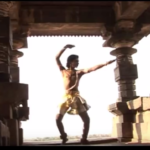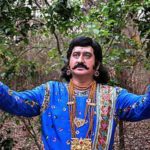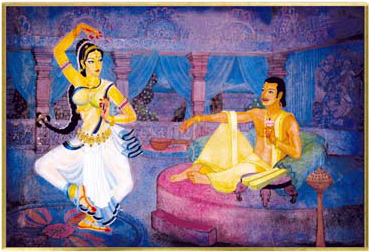
Those of you following us on our All-India site, Indic Civilizational Portal, would have seen our article on Vasant Utsav. Well, it just so happens that Andhra had a king who became so identified with the festival, he took his name after it.
The next installment in our Continuing Series on Andhra Personalities is none other than King Kumaragiri Reddi, better known as: Vasantaraya.
Background
Kumaragiri Reddi (1386-1403 CE) was the son of Anavota I. He succeeded his uncle Anavema after the latter’s highly successful reign as the greatest king of the dynasty. “The Anaparti grant, his earliest extant record, dated in S.1312/1390 A.D., says that he had, by that year, friendly relations with the kings of the north, east, south and west. ” [1, 122] His reign is generally considered to have run from 1386 to 1403,
The family tree of the Reddi dynasty also plays an important part in the fate of the Kingdom. As previously discussed, there were 3 main families that decided its fate: the descendants of Prolaya Vema Reddi, Maacha I, and Kaataya Reddi. Thus we see that “Kumaaragiri’s succession to the throne was not a smooth and peaceful one and that he had to fight for it.” [1,122]
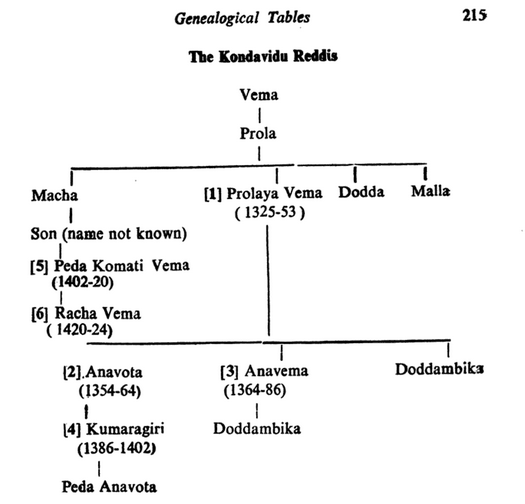
The “rival claimants to the throne might have been his cousins, Vema and Maaca, sons of Peda Komati, and grandsons of Maaca I, brother of Prolaya Vema.”[1,123]
Despite being known more as a man of culture and less as a warrior-general, it is said that…
Kumaaragiri fought successful wars with the kings of the west, north and east, that is, probably with Vijayanagar, Raajakonda and Kalinga respectively. [1, 126]
Either way, the meteoric expansion of the Reddi dynasty that occurred under Kaataya Vema’s generalship, also led to its later contraction, final division, and downfall. The campaigns of this era, therefore, are better attributed to Kaataya than Kumaragiri, and should be described under his account, focusing on Vasantaraya today.
Vasantaraya
A man of pleasure, learning, and celebration, Kumaragiri revived the ancient Vasantha Utsavam (spring festival).
There was a great carnival and the King would go to a park specially decorated for Vasant. There would be a pandal for Kama and Rati, Vishnu and Lakshmi, Siva and Sakti, and Sachi and Indra. Perfumes such as camphor, musk, civet, saffron, sandal were used, rosewater was freely sprinkled on people along with water mixed with turmeric. A bamboo water soaker was used (like pichkaris in holi). “The sport included sprinkling and scattering of various powders, coloured and un-coloured, perfumed and non-perfumed, and sandal paste. Camphor pieces and powder were showered on the crowds” [1, 358] People mixed freely and the Reddi kings, especially Karpoora-Vasantharaya, gave it royal grandeur.
He generally left administration to his brother-in-law, Kataya Vema Reddi, to pursue artistic and literary interests.
He was a great lover of music and dance and studied all the old works on dance written by Bharataacaaryas and dance-experts and produced a comprehensive work on that art called Vasantaraajeeya after his own name. [1,145]
The sanskrit treatise on dance was called Vasantharaajeeya as he was called Vasantaraya. A man of art and aesthetics was naturally a great lover of loveliness. He was said to have been enamoured by the narthaki Lakumadevi, who was a stunning beauty. The love story between the two is a touching tragedy, as recounted here, but is nevertheless symbolic of the sacrifice and burdens of ruling a kingdom.
Due to varied attacks from the Bahmanis, Recherlas, and Vijayanagara Emperors, Kumaragiri had many threats to face. Kumaragiri eventually elevated Kaataya Vema to generalissimo.
They were simultaneously attacked by the Gajapatis who were defeated outside of Viharanagari or Kridaad. Vijayanagara also attacked and occupied a portion of the south. Kumaragiri also had to face a rebellion by the Kandukuru branch, and prince Komati Reddi, son of Maacha I occupied territories as far as Tenali in Guntur district. [1, 148]
An invasion by the Bahmanis, under Firuz Shah, threatened the Reddi kingdom in 1398 C.E. “Gajaraavu Tippaa Naayaka, a distinguished noble of the kingdom, appears to have defeated the muslims on the plain outside the town of Kambamumetta and driven them back.” [1,147]
A matrimonial alliance was concluded with Vijayanagara, and Kaataya Vema was given Harihara Raya’s daughter (Hariharamba) in marriage. This would have ramifications on the Reddi Kingdom in a few years. Kaataya Vema would go on to make conquests in the East and expand the dynasty’s direct rule to Rajamahendri.
As mentioned previously, the campaigns to Bengal are better discussed in future articles. Nevertheless, Kumaragiri’s military commanders such as Kaataya Vema and Allaya Reddi are said to have taken Vasantaraya’s banner to central and eastern India. Another name that bears mention is Ariyeti Annamantri (from the family of Musunuri fame). He was appointed governor of the fort of Bendapudi.
Kumaragiri’s only son and viceroy at Raajamahendravaram, Anavota II, died prematurely, some time around the year 1395. He therefore appointed his brother-in-law and prime minister Kaataya Vema the Raajamendri Rajya ruler, out of gratitude for recovering southern territories from Vijayanagara. “This step caused considerable discontent in the country and we cannot call Kumaaragiri’s action exactly wise. Kaataya Vema, always had many bitter opponents in the court. Peda Komati Vema and his supporters had always looked askance at his achievements; and their jealousy and resentment at this signal recognition by their king, of this daring rival of theirs must have been impossible to bear.” [1,146]
This led to an internecine dispute within the dynasty, and Pedda Komati Vema took back the throne for the main line of Reddis and drove away Kumaragiri, who took refuge in Kaataya Vema’s court at Rajamahendri. This also led to division of the Reddi kingdom, and courts at Rajamahendravaram and Kondaveedu warred with each other. Kumaragiri Vijayam, rather ironically, marks his reign.
Vasantaraya’s rule ended under his viceroy’s protective care. King Kumaragiri passed away in 1402 C.E., with no heirs.
Achievements

While the Reddi Kings traditionally had reputations as warrior-generals and as defenders of Dharma, King Kumaragiri demonstrated the softer power of culture that they also wielded. If Kaataya Vema represented the Vaana (arrow) of his reign, Kumaragiri represented the Veena (lute).
Perhaps nothing showed this more than the Vasanta Utsava from which Vasantaraya takes his name. Although this title was also attributed to his predecessor, it is Kumaragiri who truly owned it. The enthusiasm with which he celebrated that festival, rightly earned him the title of Vasantaraaya, which was later embellished to Karpoora-Vasantaraaya by the generous quantities of camphor he scattered among people during this festival. [1, 145]
- Celebrated and Revived the ancient Spring Festival known as Vasant Utsav
- Well-read Sanskrit scholar and authority on dance and music
- Composed a respected Sanskrit text on Dance called Vasantarajeeya (now lost).
- Brought the Reddi Dynasty to new cultural heights, with not only learned Brahmanas but the Aristocracy and the King himself actively leading literary and musical accomplishment
- Gave patronage to a large circle of cultural exemplars, such as poet Annayya, son of Pinnayya, son of Manuma Durgasuddhi.
- Presided over the most widespread, successful campaigning of the Reddi Kingdom, with commanders such as Kaataya Vema and Allaya Reddi. Under him, Coastal Andhra arms reached as far as Odisha, Bengal and Jharkhand.
- Led a building programme which beautified Kondaveedu and constructed many structures such as the grha-raaja samjhanam, dedicated to Goddess Lakshmi.
Legacy
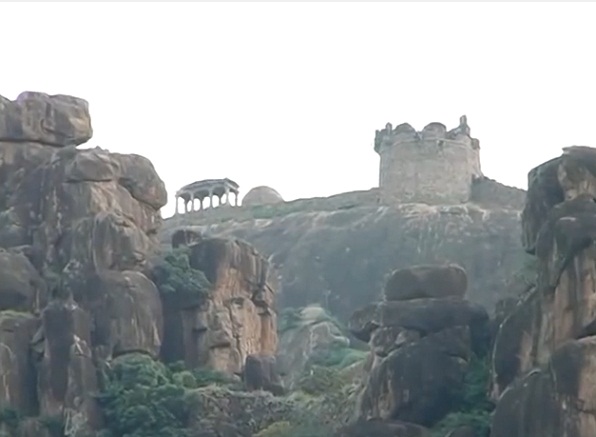
Kumaragiri’s rule is recorded in the work Kumaragiri Vijayam. From his brave biruda-rahatta (knights-cavaliers) to his love for Lakumadevi to his Vasantarajeeya to his revival of the Vasanta Utsava, Vasantaraya’s reign truly represented the noon-tide of the Reddi Rajyam: The Romantic Age of Andhra.
King Kumaragiri was freed from burden of ruling & became a lover of music & arts. He was an artist (kalaavan) in every sense. “Vasantaraaya (another name of Kumaaragiri) constructed many pleasure houses (leelagrhaan) with gold and precious stones, a lofty palatial mansion, termed grharaaja-prasada with pinnacles (prasaadam-unnata-sikha griharaaja-samjnam), pleasure-ponds (kreedaasaraamsi) and pleasure-chariots (keli-radhaan), and sported with his beloved women (priyaabhih).” [1,449]
Despite the cultural accomplishment of Vasantaraya, his reign shows the dangers of a king completely outsourcing administrative responsibility to his Prime Minister and other officials. Kaataya Vema was a skilled general and brave warrior, but his own ambition for power led to the break up of the Reddi Raajyam. The Antar-yuddham or Civil War in which it was plunged later in King Kumaragiri’s reign demonstrated this danger.
The Reddi kingdom split up in 1402 CE, with Pedda Komati Vema taking the throne of Kondaveedu from Kumaragiri, who fled to Raajamahendri. While Kumaragiri nominally ruled, it was Kaataya Vema who was the real power behind the throne. It was thus natural that after Kumaragiri’s passing, that Kaataya Vema would formalise his bid for power. Despite his loyalty to Kumaragiri, once the way was clear, he would make his own claim to the throne, and the warring of the Reddi kingdoms made the downfall of both inevitable.
In the succeeding decades, Vijayanagara would swallow up Kondaveedu and the Gajapathis of Odisha would take over Raajamahendravaram. Kumaragiri may not be directly to blame for this outcome, but his reign shows the danger of a king retiring completely from administration and becoming too dependent on ministers, and especially, prime ministers.
Nevertheless, Kumaragiri will remain Vasantaraya in the hearts of Andhras, not only for reviving this great festival, with which he is identified, but for truly making the Reddi Rajyam the Romantic Age of Andhra.

References:
- M.Somasekhara Sarma. History of the Reddi Kingdoms.Delhi:Facsimile Publ. 2015.
- Rao, P.R. History and Culture of Andhra Pradesh: From the earliest times to 1991. Delhi: Sterling. 1994
- http://gloriousindianpast.blogspot.com/2016/01/lakuma-devi.html
- Prasad, Durga. History of the Andhras. P.G. Publishers. 1988

